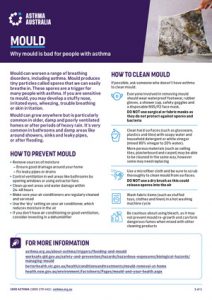Flooding and mould
Mould can grow at any time. It’s very common in damp places like showers, sinks and near leaky pipes. But flooding, major rain events or cyclones can cause large scale damage. Water damage to buildings can lead to extra mould growth. Mould can also grow in poorly ventilated or maintained homes.
Moulds produce millions of airborne spores that can be inhaled. Breathing in mould can irritate your airways or trigger an allergic response. Both types of reactions can lead to asthma flare-ups and a range of other health problems. If you are sensitive to mould, you might get a stuffy nose, itchy eyes, wheezing, trouble breathing or skin irritation when you are exposed to it. Rarely, mould spores can cause damage to your lungs or airways and lead to serious side effects.
TIPS FOR REMOVING MOULD
- If possible, ask someone who doesn’t have asthma to clean mould.
- Wear waterproof footwear, rubber gloves, a shower cap, safety goggles and a disposable N95/P2 face mask. Surgical and fabric masks do not protect against spores and bacteria.
- Clean hard surfaces with soapy water and household detergent or white vinegar (mixed 80% vinegar to 20% water). This includes glassware, plastics and tiles.
- More porous materials may be able to be cleaned in the same way, but some may need replacing. This could include ceiling tiles, plasterboard and carpet.
- Use a microfiber cloth and be sure to scrub well. DO NOT use a dry brush as this could release spores into the air.
- Wash fabric items (such as stuffed toys, clothes and linen) in a hot washing machine cycle.
- Be cautious about using bleach, as it may not prevent mould re-growth. Bleach can form dangerous fumes when mixed with other cleaning products.
Asthma Educators can answer your asthma questions
Book a FREE phone call at a time that works for you or call us direct on 1800ASTHMA (1800 278 462).










